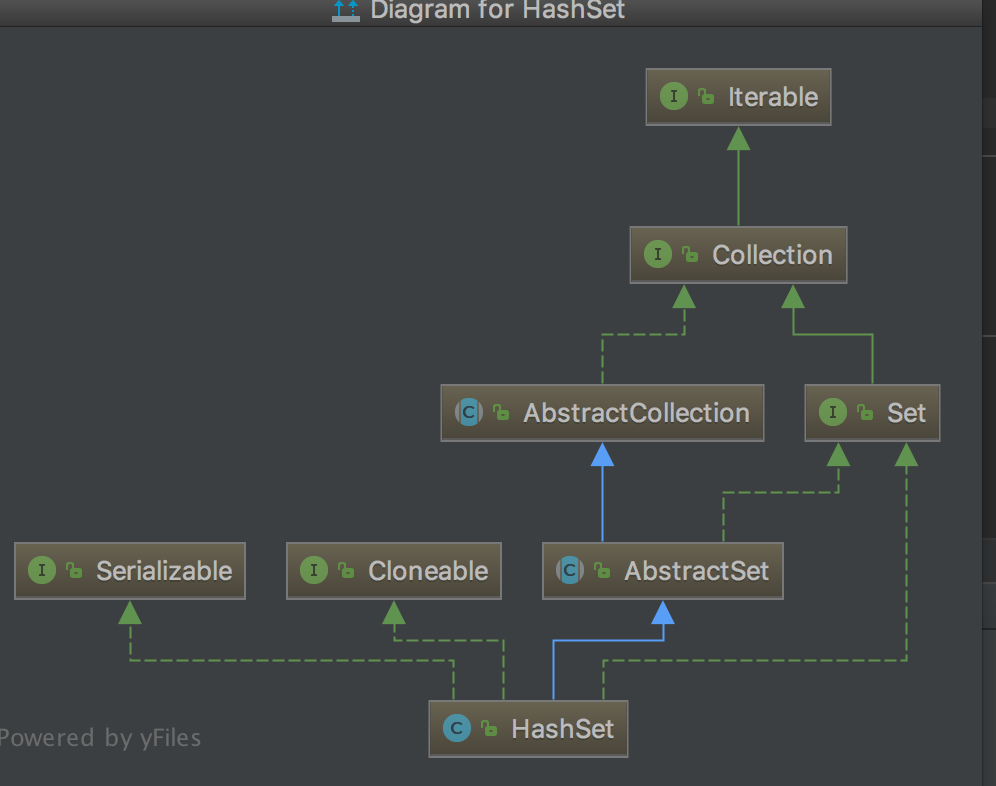背景
由于HashMap的源码我们已经分析过了原来你是这样的HashMap(1.7)
那么基于已经有的容器我们要如何做HashSet的实现呢?
以下我们将简单描述一下实现流程
源码
类图

构造函数
/** * Constructs a new, empty set; the backing <tt>HashMap</tt> instance has * default initial capacity (16) and load factor (0.75). */ public HashSet() { map = new HashMap<>(); } /** * Constructs a new set containing the elements in the specified * collection. The <tt>HashMap</tt> is created with default load factor * (0.75) and an initial capacity sufficient to contain the elements in * the specified collection. * * @param c the collection whose elements are to be placed into this set * @throws NullPointerException if the specified collection is null */ public HashSet(Collection<? extends E> c) { map = new HashMap<>(Math.max((int) (c.size()/.75f) + 1, 16)); addAll(c); } /** * Constructs a new, empty set; the backing <tt>HashMap</tt> instance has * the specified initial capacity and the specified load factor. * * @param initialCapacity the initial capacity of the hash map * @param loadFactor the load factor of the hash map * @throws IllegalArgumentException if the initial capacity is less * than zero, or if the load factor is nonpositive */ public HashSet(int initialCapacity, float loadFactor) { map = new HashMap<>(initialCapacity, loadFactor); } /** * Constructs a new, empty set; the backing <tt>HashMap</tt> instance has * the specified initial capacity and default load factor (0.75). * * @param initialCapacity the initial capacity of the hash table * @throws IllegalArgumentException if the initial capacity is less * than zero */ public HashSet(int initialCapacity) { map = new HashMap<>(initialCapacity); } /** * Constructs a new, empty linked hash set. (This package private * constructor is only used by LinkedHashSet.) The backing * HashMap instance is a LinkedHashMap with the specified initial * capacity and the specified load factor. * * @param initialCapacity the initial capacity of the hash map * @param loadFactor the load factor of the hash map * @param dummy ignored (distinguishes this * constructor from other int, float constructor.) * @throws IllegalArgumentException if the initial capacity is less * than zero, or if the load factor is nonpositive */ HashSet(int initialCapacity, float loadFactor, boolean dummy) { map = new LinkedHashMap<>(initialCapacity, loadFactor); }
那么思路很明确了,就是直接使用HashMap作为容器。
那么HashSet放入HashMap的value直接用一个默认对象即可。
// Dummy value to associate with an Object in the backing Map private static final Object PRESENT = new Object();
搞定收工!
这也是一种常见的委托模式(只暴露自己想要暴露的接口)


